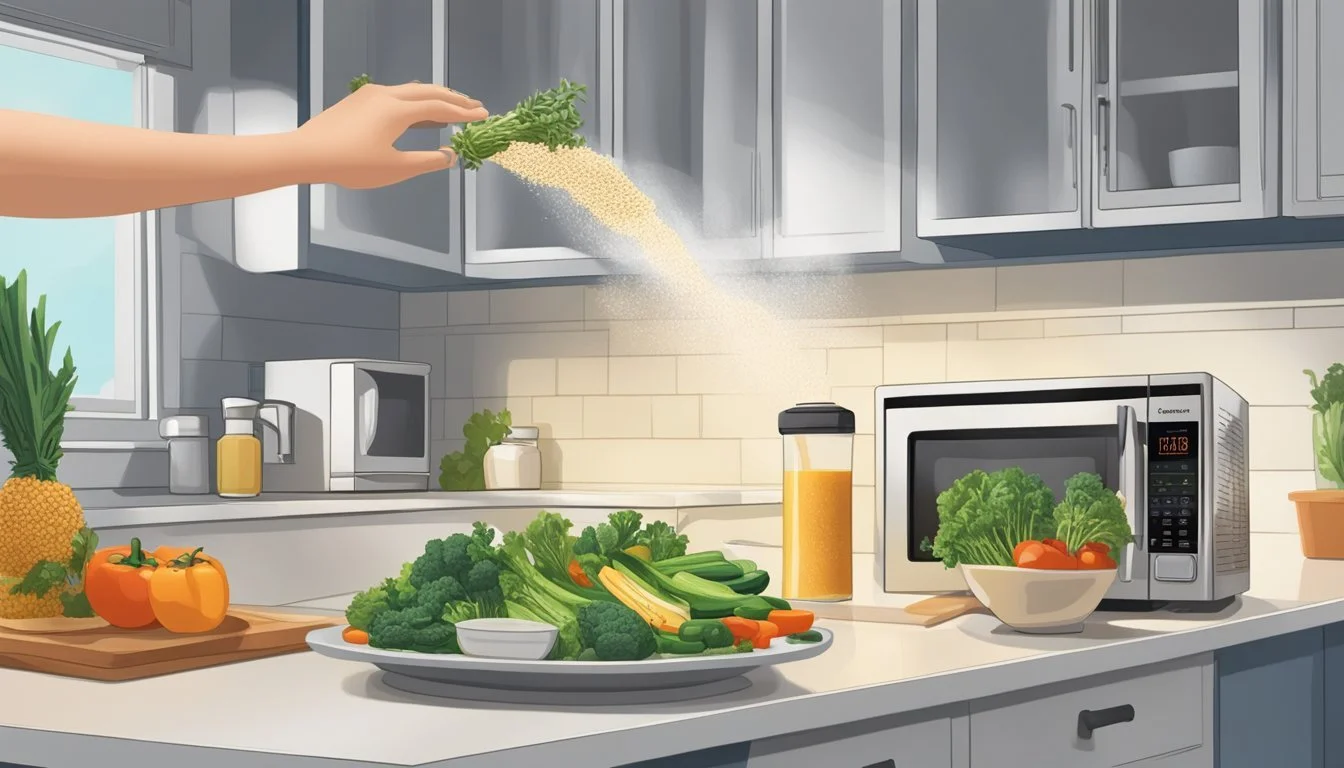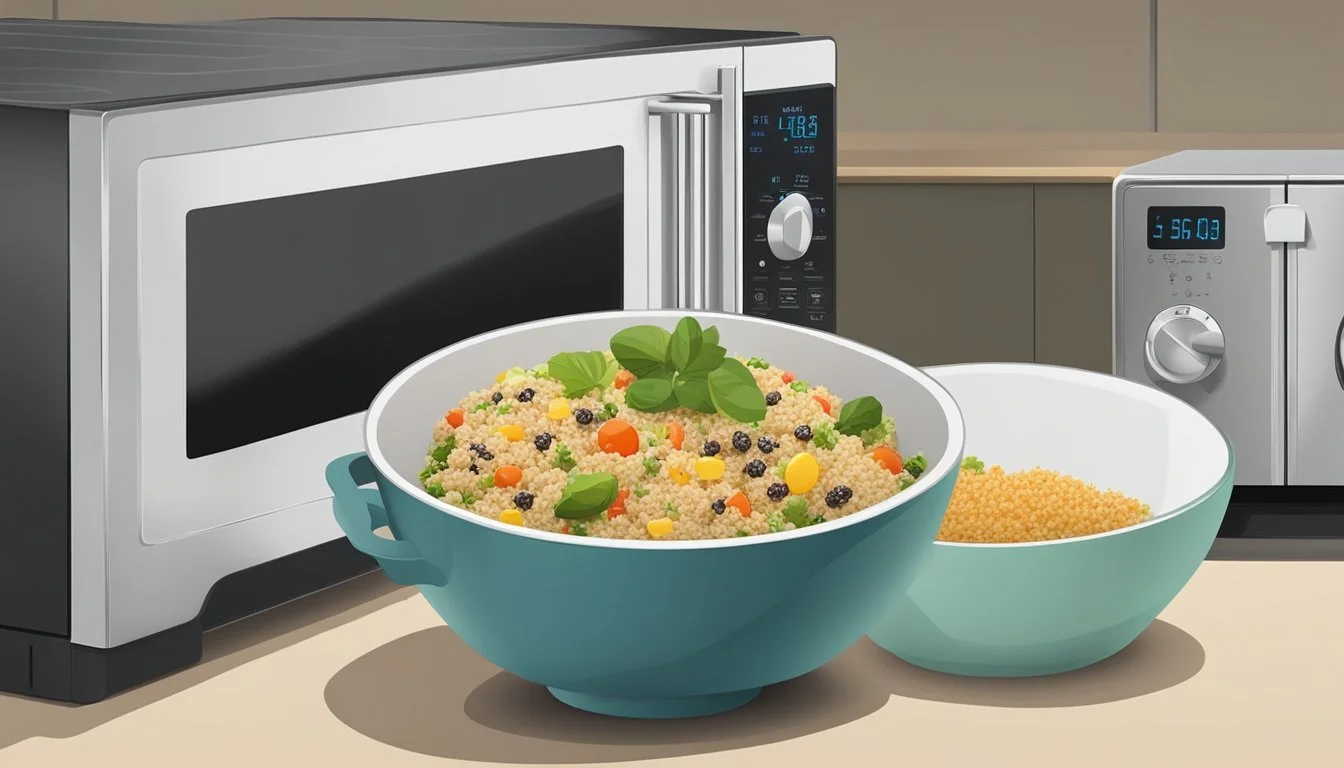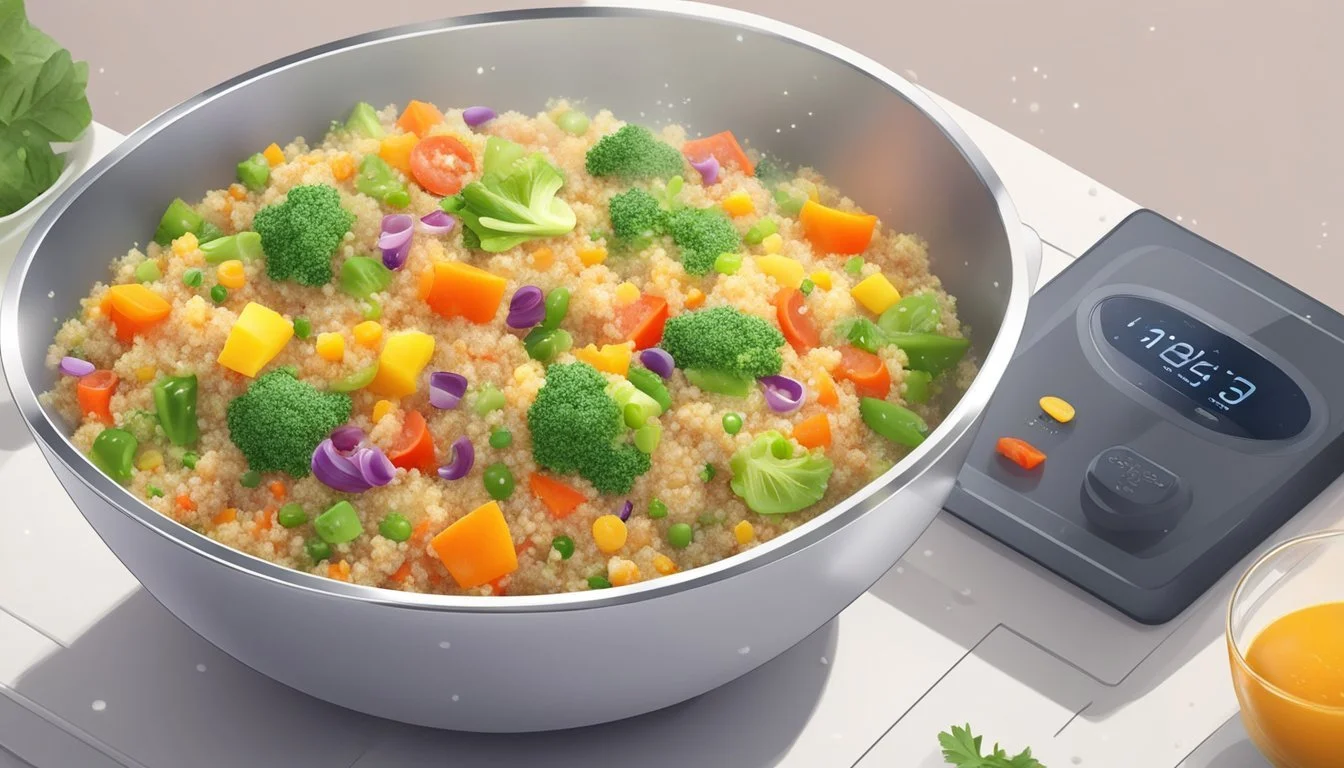How to Reheat Gluten-Free Quinoa Salad Perfectly Every Time
Reheating a gluten-free quinoa salad might seem straightforward, but retaining its perfect texture and flavor requires a bit of know-how. To ensure your quinoa salad remains delicious and maintains its nutritional value, reheating it correctly is crucial. This guide will help you transform your prepared quinoa salad into a mouth-watering meal, whether you're grabbing lunch on a busy day or serving it at a family dinner.
Quinoa, being gluten-free and protein-rich, is a staple in many health-conscious kitchens. When properly reheated, a quinoa salad can taste just as fresh and vibrant as when it was first made. Covering the salad with a damp paper towel before microwaving it is a key step to lock in moisture and prevent drying out.
For those who meal prep, knowing the best techniques to reheat quinoa salad can save time and enhance your eating experience. Keeping the salad components like veggies and dressings separate until reheating can also help in maintaining the salad's texture. With these tips, your gluten-free quinoa salad will be just as satisfying and nutritious as the day it was prepared.
Understanding Quinoa Salad
Quinoa salad is a versatile dish that is both gluten-free and packed with nutrients. Quinoa itself is a seed known for being rich in protein and fiber, making it a popular choice for healthy eating.
Quinoa can be cooked quickly and serves as an excellent base for salads. Once cooked, it has a fluffy yet slightly crunchy texture.
Many vegetables can be incorporated into quinoa salads, such as cucumbers, cherry tomatoes, and olives. These add color and additional nutrients to the dish.
The gluten-free nature of quinoa makes it an ideal choice for those with celiac disease or gluten sensitivity.
Quinoa salad can serve as either a main dish or a side dish, depending on the portion size and added ingredients.
Quinoa salad is delicious when dressed with simple ingredients like olive oil, lemon juice, and various herbs and spices.
This makes it easy to customize according to personal taste.
Selecting Ingredients
To create a delicious gluten-free quinoa salad, focus on selecting the best ingredients. This ensures the dish is not only flavorful but also nutritious and satisfying.
Choosing Quinoa Varieties
Quinoa comes in several varieties, each offering unique textures and flavors. White quinoa is the most common and has a mild taste, making it suitable for many recipes. Red quinoa has a slightly nuttier flavor and firmer texture, which can add an interesting dimension to your salad. Black quinoa is the earthiest of the three and retains its shape well, providing a visually appealing contrast. Mixing different quinoa types can enhance the salad's appeal and provide varied nutrient profiles.
Picking Fresh Vegetables
Using fresh vegetables is crucial for a vibrant and tasty salad. Cucumbers and cherry tomatoes should be firm and free of blemishes. Bell peppers add a sweet crunch and come in various colors, contributing both to flavor and visual appeal. Parsley and mint are excellent fresh herbs that add aromatic notes. Always wash the vegetables and herbs thoroughly before use, and chop them right before adding them to the salad to retain their freshness.
Opting for High-Quality Proteins
Including high-quality proteins makes the salad more filling. For a vegan option, chickpeas are an excellent choice as they blend well with the other ingredients and provide essential nutrients. Other protein options include tofu or edamame. For those who prefer dairy, feta cheese can be crumbled over the salad, adding a tangy flavor. Ensure any added proteins are fresh and properly prepared to maintain the salad’s overall quality.
Customizing Dressing Options
The dressing ties all the ingredients together. A simple and effective dressing can be made with lemon juice, olive oil, salt, and pepper. Adding a touch of red wine vinegar can enhance the flavors further. Herbs such as parsley and mint can be finely chopped and mixed into the dressing for a refreshing twist. Use a whisk to thoroughly combine the ingredients, ensuring a consistent flavor throughout the salad. Adjust the dressing to taste for the perfect balance of acidity and richness.
Preparation Techniques
Creating a gluten-free quinoa salad involves several key steps, including cooking the quinoa, chopping and preparing the vegetables, and assembling the salad. Each step is essential to ensure the salad maintains a desirable texture and flavor.
Cooking Quinoa for Salad
Start by rinsing the quinoa under cold water to remove any bitterness from its natural coating. Use a fine mesh strainer for this step.
Next, measure 1 cup of quinoa and 2 cups of water and pour them into a medium-sized pan. Add a pinch of salt for flavor enhancement. Bring the mixture to a boil over medium-high heat. Once boiling, reduce the heat to a simmer, cover, and cook for about 15 minutes.
Check if all the water has been absorbed and the quinoa is tender. If the quinoa appears cooked but still has water, remove the lid and continue cooking on low heat until the water evaporates. Once done, fluff the quinoa with a fork and let it cool completely before using it in the salad to ensure the best texture.
Chopping and Preparing Vegetables
Fresh vegetables are key to a vibrant quinoa salad. Common choices include cucumbers, cherry tomatoes, bell peppers, and olives.
Begin by thoroughly washing all vegetables. Chop cucumbers into quarter slices and halve the cherry tomatoes. Slice bell peppers into thin strips and halve or slice olives.
For added flavor, consider incorporating finely minced garlic. A small amount of lemon zest can also provide a refreshing touch. Organize the chopped vegetables in separate bowls or a large tray to streamline the assembly process.
Assembling the Salad
In a large mixing bowl, combine the cooked quinoa and prepared vegetables. Stir gently to mix the ingredients evenly. For the dressing, mix olive oil, lemon juice, a splash of red wine vinegar, minced garlic, and salt and pepper in a smaller bowl. Whisk until the ingredients are well combined.
Drizzle the dressing over the quinoa and vegetables. Toss the salad carefully to ensure every bite is seasoned uniformly. Allow the salad to sit for a few minutes to let the flavors meld together before serving.
Seasoning for Flavor
Enhancing the taste of gluten-free quinoa salad involves a careful balance of seasonings and the addition of fresh ingredients. Two crucial elements to focus on are balancing salt and acidity, and incorporating fresh herbs for added flavor.
Balancing Salt and Acidity
Salt and acidity are key to highlighting the natural flavors of the salad.
Salt enhances the quinoa and vegetable flavors and balances the dish. Start with a small amount, taste, and gradually add more if necessary.
Acidity from lemon juice or red wine vinegar brightens the dish, giving it a fresh, tangy profile. Lemon juice is especially effective when combined with extra virgin olive oil to create a light dressing.
For a robust flavor, add black pepper to taste. Stir the seasoning mix thoroughly to ensure even distribution.
Incorporating Fresh Herbs
Fresh herbs add depth and complexity to a quinoa salad.
Parsley is commonly used for its bright, slightly peppery taste. Finely chop and sprinkle it over the salad.
Mint gives the salad a refreshing, cool note.
Cilantro adds a unique citrus-like flavor, perfect for pairing with lemon dressing.
To maximize flavor, add the herbs just before serving. Stir them gently into the salad to maintain their delicate texture.
Mixing different herbs can create an intriguing taste profile tailored to your preference.
Reheating Methods
To ensure your gluten-free quinoa salad retains its flavor and texture, it's crucial to use the right reheating techniques. Whether you prefer the stovetop, microwave, or oven, each method offers unique advantages.
Using a Stovetop
Reheating quinoa salad on the stovetop requires using gentle heat to prevent overcooking. First, place the quinoa salad in a skillet or saucepan with a splash of water or broth.
Cover the pan with a lid to trap moisture. Set the heat to low or medium. Stir occasionally to ensure even warming and prevent sticking. This method is ideal for Mediterranean-style salads that include vegetables and protein.
Warming in a Microwave
Microwaving is quick and convenient. Place the quinoa salad in a microwave-safe bowl. Break up any clumps with a fork. Cover the bowl with a damp paper towel.
Heat on high for 30-60 seconds, depending on the portion size. Stir halfway through to ensure even heating. Add another 15-30 seconds if necessary. This method preserves the salad's texture and keeps it moist.
Heating in an Oven
Using an oven is best for larger portions. Preheat the oven to 350°F (175°C). Spread the quinoa salad in an even layer on a baking sheet. Cover with aluminum foil to retain moisture.
Heat for about 10-15 minutes, stirring halfway through. For a warm Mediterranean flavor, add a drizzle of olive oil before reheating. This method evenly heats the salad and retains its freshness.
Maintaining Nutrition and Taste
To maintain the nutrition and taste of a gluten-free quinoa salad, certain practices are essential. Proper reheating methods are critical to preserve the salad's fiber and protein content.
When reheating, use a microwave-safe bowl and a damp paper towel to retain moisture. Heat for 30-60 seconds, stirring occasionally.
Alternatively, reheat on the stovetop with a dash of water or broth. Cover the saucepan to trap steam and ensure even heating.
Include fresh vegetables like cucumbers, bell peppers, and cherry tomatoes. Freshness enhances flavor and keeps the salad crunchy.
A Mediterranean quinoa salad includes ingredients known for their health benefits. Combining quinoa with vegetables ensures a balanced diet rich in complete protein.
Ensure the salad stays refrigerated when not in use. This practice helps in preserving taste and nutrition.
Serving Suggestions
Reheating gluten-free quinoa salad opens up various pairing options and garnishing ideas to elevate the dish. Discover how to pair this nutritious salad with a variety of main dishes and enhance its appeal with simple garnishes.
Pairing with Various Dishes
Quinoa salad pairs excellently with many Mediterranean and Greek dishes. Serving it alongside grilled vegetables, like zucchini and bell peppers, complements the flavors and adds nutritional value. When considering vegetarian options, think about dishes like roasted chickpeas or a simple falafel.
For meat lovers, grilled chicken or lamb make perfect partners. The savory tastes of these meats blend well with the light, tangy flavors of the quinoa salad.
In addition, this salad can serve as a great side dish for seafood recipes. Baked salmon or shrimp skewers add a refreshing taste, creating a balanced meal that’s both satisfying and healthy.
Garnishing for Enhanced Appeal
Enhancing the appeal of your reheated quinoa salad is easy with the right garnishing. Fresh herbs such as parsley, basil, or mint not only add color but also bring out the flavors of the salad.
Including a sprinkle of feta cheese can add a delightful tang and creaminess, ideal for a Greek-style presentation. Adding a handful of toasted seeds or nuts, like sunflower seeds or slivered almonds, provides a crunchy texture.
Lastly, consider adding thin slices of avocado or a few pomegranate seeds. These ingredients not only enhance the nutritional profile but also give the salad a visual and flavorful boost.
Storage and Meal Planning
Storing gluten-free quinoa salad properly and planning meals ahead of time can help maintain its freshness and flavor for longer periods. Utilize airtight containers and strategic meal prep techniques for the best results.
Proper Storage Techniques
To keep gluten-free quinoa salad fresh, store it in airtight containers. Glass containers are ideal as they prevent odors and are reusable. Place the quinoa salad in the refrigerator immediately after it cools to room temperature.
Salad should be kept at 40°F or below to avoid bacterial growth. Store it on a middle shelf where the temperature is consistent. Label each container with the date it was made to track its freshness easily. The salad generally stays fresh for 3-5 days when stored this way.
Meal Prep Strategies
When meal prepping, consider making a double batch of quinoa salad to save time in the long run. Portion the salad into individual servings for easy grab-and-go meals. Add dressing and more perishable ingredients like avocado or sliced tomatoes just before eating to keep the texture intact.
Use a combination of compatible ingredients that will hold up well over a few days, such as chickpeas, bell peppers, and cucumbers. Separate any ingredients that may wilt or become soggy if stored together. Having pre-portioned servings ready makes healthy eating more convenient and reduces time spent cooking during the week.
Health Benefits
Quinoa is a nutrient-dense food that offers numerous health benefits. With its high content of essential vitamins and minerals, it is an excellent addition to any diet, especially for those following a gluten-free lifestyle.
Exploring Nutritional Components
Quinoa is rich in nutrients such as iron, calcium, magnesium, and manganese. Each serving provides high fiber content which aids digestion and helps maintain healthy blood sugar levels.
Remarkably, quinoa is a complete protein, containing all nine essential amino acids that the body cannot produce on its own. This makes it an ideal plant-based protein source, particularly valuable for vegetarians and vegans. The high levels of vitamins and minerals boost overall well-being and contribute to various bodily functions.
Dietary Advantages of Quinoa
For those sensitive to gluten or with celiac disease, quinoa is an excellent gluten-free alternative. It not only fulfills dietary needs but also offers substantial dietary advantages. Its high fiber content helps in weight management by providing a feeling of fullness, which can reduce overall calorie intake.
Moreover, the presence of essential amino acids and minerals supports muscle recovery, bone health, and offers sustained energy levels throughout the day. The iron content helps in the formation of red blood cells, enhancing oxygen transport in the body, while magnesium and calcium are pivotal for bone health. The dietary benefits make quinoa a versatile and healthy food choice.











